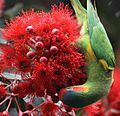Musk lorikeet facts for kids
Quick facts for kids Musk lorikeet |
|
|---|---|
 |
|
| Conservation status | |
| Scientific classification | |
| Genus: |
Glossopsitta
|
| Species: |
concinna
|
The musk lorikeet (Glossopsitta concinna) is a type of lorikeet. It is the only species left in its group, called Glossopsitta. These colorful birds live in south-central and eastern Australia.
The musk lorikeet was first described in 1790 by a scientist named George Shaw. He found it near Port Jackson, which is now Sydney. Its scientific name, concinna, means "elegant" in Latin. People also call it the red-eared lorikeet or green keet.
What Does It Look Like?
The musk lorikeet is about 22 centimetres (8.7 in) long. It is mostly green. You can easily spot it by its bright red forehead and a blue patch on its head. It also has a clear yellow band on its wing. Both the top and bottom parts of its beak are red at the tip and darker near the base.
Where Do They Live?
Musk lorikeets live in eastern New South Wales, Victoria, South Australia, and Tasmania. They are often found moving around in woodlands and drier forests. On the mainland, they mostly live west of the Great Dividing Range.
These birds have recently been seen visiting fruit trees in areas like Punchbowl in Northern Tasmania. They enjoy eating apricots, apples, and the nectar from bottlebrush flowers. They also eat seeds and nectar from Grevillea plants.
Living in Cities
Musk lorikeets are one of the few animals that can adapt well to fast-growing cities. Over the last 30 years, many flocks of musk lorikeets have started living in Australian cities like Melbourne and Sydney.
One big reason they move to cities is because people plant many nectar-producing trees there. Lorikeets have evolved to eat nectar as a main part of their diet. They can often be seen feeding in the blooming trees of eucalyptus forests.
City plants are usually well-cared for, making them a steady food source. The outer parts of cities often have more of these nectar plants. This gives the lorikeets more places to feed and rest. While some are seen in inner city areas, their numbers are lower due to less greenery.
The rainbow lorikeet also eats nectar and lives in cities. This means both types of lorikeets need the same food. They must compete for the limited food available. The growing number of rainbow lorikeets and increasing city development might make it harder for musk lorikeets to find enough food.
Reproduction
Musk lorikeets usually breed from August to January. They build their nests in hollow tree limbs, high up in a tree. The female lays two white eggs, which are about 24 mm × 20 mm (0.94 in × 0.79 in). She sits on the eggs for 22 days to keep them warm. The young birds are ready to fly after about 5 to 6 weeks.
Gallery
See also
 In Spanish: Lori almizclero para niños
In Spanish: Lori almizclero para niños




